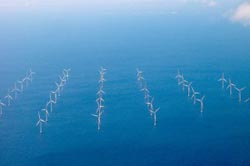Wind Energy: Staggering Turbines Improves Performance 33%

Mariusz PaŸdziora, Wikipedia Commons<br><br>UD researchers found that staggering, instead of aligning, rows of wind turbines in the Lillgrund Wind Farm would have improved performance.<br>
The University of Delaware’s Cristina Archer and her Atmosphere and Energy Research Group found that staggering and spacing out turbines in an offshore wind farm can improve performance by as much as 33 percent.
“Staggering every other row was amazingly efficient,” said Archer, associate professor of physical ocean science and engineering and geography in UD’s College of Earth, Ocean, and Environment.
The findings, which appeared last month in Geophysical Research Letters, could help engineers plan improved offshore wind farms.
The researchers used an existing offshore wind farm near Sweden as the basis for their study, comparing the existing tightly packed, grid-like layout to six alternative configurations. In some, they kept the turbines in neat rows but spaced them farther apart. In others, they shifted the alignment of every other row, similar to how rows of theatre seats are staggered to improve the views of people further back.
In computer-intensive simulations that each took weeks to run, the team took into account the eddies, or swirls of choppy air, that wind turbines create downwind as their blades spin — and how that air movement would impact surrounding turbines.
They found that the most efficient arrangement was a combination of two approaches. By both spacing the turbines farther apart and staggering the rows, the improved layout would decrease losses caused by eddies and improve overall performance by a third.
The optimal configuration had the rows oriented to face the prevailing wind direction, for example from the southwest in the summer along the U.S. East Coast. Most locations, however, have more than one dominant direction from where wind blows throughout the year. The optimal configuration for a season may not be optimal in another season, when the prevailing wind changes direction and intensity.
Considering these various factors could better inform where and how to configure future offshore wind farms, Archer explained.
“We want to explore all these trade-offs systematically, one by one,” she said.
The study is part of Archer’s overall research focus on wind and applications for renewable energy production. Trained in both meteorology and engineering, she uses weather data and complex calculations to estimate the potential for wind as a power source.
Last year, Archer and colleague Mark Jacobson of Stanford University found that wind turbines could power half the world’s future energy demands with minimal environmental impact.
In a follow-up to that study, Archer and Jacobson examined how worldwide wind energy potential varies seasonally. They found that in most regions where wind farms could feasibly be built on land and offshore, capacity is greatest from December to February.
However, even factoring in seasonal variability, the researchers found there is enough wind to cover regional electricity demand.
Those results were recently published in Applied Geography and share detailed maps and tables that summarize the distribution of wind throughout the world by season.
“I’m hoping these will be tools for giving a general overview of wind at the global scale,” Archer said.
About UD’s College of Earth, Ocean, and Environment
UD’s College of Earth, Ocean, and Environment (CEOE) strives to reach a deeper understanding of the planet and improve stewardship of environmental resources. CEOE faculty and students examine complex information from multiple disciplines with the knowledge that science and society are firmly linked and solutions to environmental challenges can be synonymous with positive economic impact.
The college brings the latest advances in technology to bear on both teaching and conducting ocean, earth and atmospheric research. Current focus areas are ecosystem health and society, environmental observing and forecasting, and marine renewable energy and sustainability.
CEOE is the administrative base of the Delaware Geological Survey, the Delaware Geographic Alliance and the Delaware Sea Grant College Program and is home to the secretariat of the Scientific Committee on Oceanic Research.
Media Contact
More Information:
http://www.udel.eduAll latest news from the category: Power and Electrical Engineering
This topic covers issues related to energy generation, conversion, transportation and consumption and how the industry is addressing the challenge of energy efficiency in general.
innovations-report provides in-depth and informative reports and articles on subjects ranging from wind energy, fuel cell technology, solar energy, geothermal energy, petroleum, gas, nuclear engineering, alternative energy and energy efficiency to fusion, hydrogen and superconductor technologies.
Newest articles

Superradiant atoms could push the boundaries of how precisely time can be measured
Superradiant atoms can help us measure time more precisely than ever. In a new study, researchers from the University of Copenhagen present a new method for measuring the time interval,…

Ion thermoelectric conversion devices for near room temperature
The electrode sheet of the thermoelectric device consists of ionic hydrogel, which is sandwiched between the electrodes to form, and the Prussian blue on the electrode undergoes a redox reaction…

Zap Energy achieves 37-million-degree temperatures in a compact device
New publication reports record electron temperatures for a small-scale, sheared-flow-stabilized Z-pinch fusion device. In the nine decades since humans first produced fusion reactions, only a few fusion technologies have demonstrated…





















